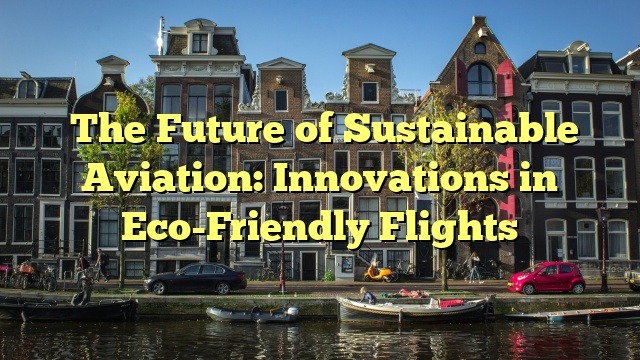The Future of Sustainable Aviation: Innovations in Eco-Friendly Flights
Understanding the Need for Sustainable Aviation
The Environmental Impact of Traditional Aviation
Commercial aviation has been a critical component of global transportation infrastructure, facilitating international travel and trade. However, it comes with substantial environmental costs. The aviation industry contributes approximately 2-3% of global CO2 emissions, with other pollutants exacerbating environmental issues such as global warming and air quality degradation. Aviation also emits nitrogen oxides (NOx), which lead to ozone formation and potential respiratory problems. Therefore, reducing the environmental footprint of aviation becomes imperative for a sustainable future.
Global Commitments to Reduce Emissions
In response to these challenges, various global agreements and initiatives have been set in motion. The International Air Transport Association (IATA) has committed to achieving net-zero carbon emissions by 2050, with intermediate goals for the years ahead. The Carbon Offsetting and Reduction Scheme for International Aviation (CORSIA) aims to cap emissions and balance growth with ecological responsibility. These frameworks highlight the urgent need to align aviation growth with sustainability goals.
Innovations Driving Sustainable Aviation
Alternative Fuels and Energy Sources
One promising avenue for reducing aviation’s harmful environmental impact involves the development of alternative fuels. Sustainable Aviation Fuel (SAF), derived from renewable resources, can significantly reduce emissions compared to conventional jet fuels.
Sustainable Aviation Fuel (SAF)
SAFs are derived from biogenic sources like plant material, waste oils, and even household waste. These fuels can potentially reduce lifecycle carbon emissions by up to 80% compared to traditional jet fuels. As of today, airlines have begun integrating SAFs into their fuel sourcing, although widespread adoption remains hampered by high production costs and limited availability.
Electric and Hybrid-Electric Propulsion
Electric and hybrid-electric aircraft represent another leap toward sustainable aviation. Battery technology and electric propulsion provide a path to reduce in-flight emissions. Though current battery technology limits their use to shorter, regional flights, ongoing research into energy density improvements has the potential to expand their range and application.
Innovative Aircraft Designs
The design of an aircraft plays a significant role in fuel efficiency and environmental impact. New, innovative designs promise not only to revolutionize aerodynamics but also to reduce drag and fuel consumption.
Blended Wing Body (BWB)
The Blended Wing Body is a revolutionary design where the traditional fuselage and wings blend into a single airfoil shape. This design offers better lift-to-drag ratios, resulting in improved fuel efficiency. By distributing the payload over a larger area, BWBs also hold promise for a more comfortable passenger experience.
Climate-Adaptive Aircraft
With technological advancement, aircraft can integrate systems that adapt to climate conditions, optimizing flight paths to minimize contrails—a significant contributor to climate change. Technologies using real-time data on weather patterns can adjust cruising altitudes, potentially reducing the climate impact.
Innovations in Airport and Airline Operations
Beyond the aircraft themselves, operational efficiencies present opportunities for sustainability. Enhanced Airport Operations and NextGen Air Traffic Control stand out in reducing inefficiencies.
Hybrid Ground Operations
At airports, innovations in ground operations like electric tugs and vehicles reduce fuel consumption on the tarmac. Furthermore, incorporating alternative energy sources such as solar and wind power at airports can minimize environmental impacts. Energy-efficient buildings and optimally designed terminals further contribute to the sustainability goals.
NextGen Air Traffic Management
The NextGen air traffic control initiative utilizes advanced satellite-based systems that allow for more efficient flight paths. By optimizing routings and altitudes, airlines improve fuel efficiency, reducing delays and emissions. This approach not only benefits airlines economically but also reduces their carbon footprints.
Challenges to Implementing Eco-Friendly Flights
Economic and Infrastructural Barriers
Transitioning to sustainable aviation presents distinct economic and infrastructural challenges. The cost of developing and implementing new technologies can be prohibitive, with research and development requiring significant investment.
High Costs of Hydrogen and SAF Production
Although SAFs and hydrogen stand at the forefront of aviation sustainability, their current production costs are significantly higher than conventional jet fuels. Investments into large-scale production facilities and supply chains are vital for their economic viability.
Retrofitting Existing Aircraft
Adapting existing aircraft to new technologies poses technical and financial challenges. While new builds can incorporate the latest sustainable technologies, transitioning the existing global fleet remains a complex issue due to cost and compatibility hurdles.
Regulatory and Policy Challenges
Global coordination on regulations and policies is necessary to achieve sustainable aviation targets. Disparities between regions can create compliance issues and lead to economic inequalities in implementation.
Standardizing Emission Reductions
Currently, emissions reduction strategies and regulations vary drastically between different geographical regions, potentially hindering global industry cooperation. Efforts to standardize emissions reduction practices would facilitate more widespread, seamless adoption of sustainable technologies.
Navigating International Policies
Because international air travel crosses numerous borders, concomitant regulations must address diverse national priorities and policies. Establishing an internationally recognized framework for emissions and sustainability standards is critical.
The Role of Collaboration in Sustainable Aviation
Partnerships Across Industry Stakeholders
Collaboration among airlines, manufacturers, governing bodies, and researchers can accelerate the transition to sustainable aviation. These partnerships allow for knowledge sharing, joint investments, and economic efficiencies in R&D.
Joint Ventures and Research Centers
By pooling resources and expertise through joint ventures, industry stakeholders can develop sustainable technologies and infrastructures more quickly and effectively. Collaborations between universities and companies play a significant role in this area.
Public-Private Partnerships
Public-private partnerships can help mitigate high initial costs of infrastructure development while ensuring public interests align with industry goals. Government incentives and support can encourage innovation and adoption of sustainable aviation technologies.
Role of Governments and Policy Makers
Governmental action, through policy creation and incentive provisioning, is fundamental in promoting an eco-friendly aviation sector.
Incentivizing Research and Innovation
Governments play a critical role in providing funding and tax incentives that spur innovative development. Grants and subsidies for the production of SAFs, development of electric aircraft, and improvement of airport energy efficiency can accelerate the pace of change.
Implementing Carbon Pricing
Carbon pricing mechanisms, like carbon taxes, can dissuade the use of high-emission fuels and foster investments in low-emission technologies. The revenue generated can be recycled back into sustainable aviation projects, creating a conducive environment for sustainable growth.
The Societal Impact of Eco-Friendly Aviation
Consumer Perceptions and Demand
Societal shift towards environmental consciousness increasingly influences consumer behaviors. Passengers are more willing to support airlines that prioritize sustainability, driving demand for eco-friendly operations.
Marketing and Brand Identity
Airlines that actively engage in sustainable practices benefit from enhanced consumer perceptions and brand loyalty. Marketing eco-friendly initiatives, such as the use of SAFs and carbon offsets, can distinguish airlines in a competitive market.
Changing Consumer Preferences
As awareness grows, consumers are now factoring environmental impacts into their travel decisions. Airlines that offer transparent sustainability practices may appeal to these environmentally-conscious travelers.
Economic Benefits Beyond the Industry
Sustainable aviation’s impact extends beyond the industry, with widespread economic benefits. Investments in eco-friendly technologies can stimulate job creation and regional economic development.
Boosting Green Technologies
Investment in aviation sustainability drives innovation and development in ancillary markets, such as renewable energy and material sciences, fostering a broader green economy with diverse opportunities.
Regional Development Through Green Airports
Eco-friendly airport operations contribute to regional economic growth, with newly designed airports serving as incubators for sustainable business practices and tourism.
Future Prospects and Emerging Technologies
Emerging Technologies on the Horizon
The trajectory of aviation is constantly evolving, with impulsions from emerging technologies promising a paradigm shift.
Quantum Computing in Route Optimization
Quantum computing has the potential to revolutionize route optimization, factoring in a multitude of real-time variables like weather conditions and air traffic to minimize emissions efficiently. This advancement could allow for the unprecedented streamlining of operations and fuel savings.
Advanced Materials That Reduce Weight
Innovations in materials science, such as the development of lightweight composites and 3D printing, hold promise for reducing aircraft weight, leading to enhanced fuel efficiency and reduced emissions.
Looking Beyond the Horizon
The aviation industry must remain agile and adaptive as unforeseen challenges and opportunities emerge. The commitment to sustainability dictates continued exploration, collaboration, and innovation to ensure aviation’s alignment with global ecological objectives.
Vision for a Net Zero Future
While ambitious, the reality of net-zero emissions requires more than technological advancements. A holistic approach, inclusive of policy shifts, consumer engagement, and cross-industry collaboration, will enable the aviation industry to meet its sustainability targets while continuing to serve as a cornerstone of global connectivity.
In the journey towards sustainable aviation, embracing adaptive resilience and open-minded exploration will pave the way for an aviation sector aligned with the global endeavor of ecological stewardship. The future indeed holds great promise as each innovation and collaborative effort brings us closer to eco-friendly skies.































